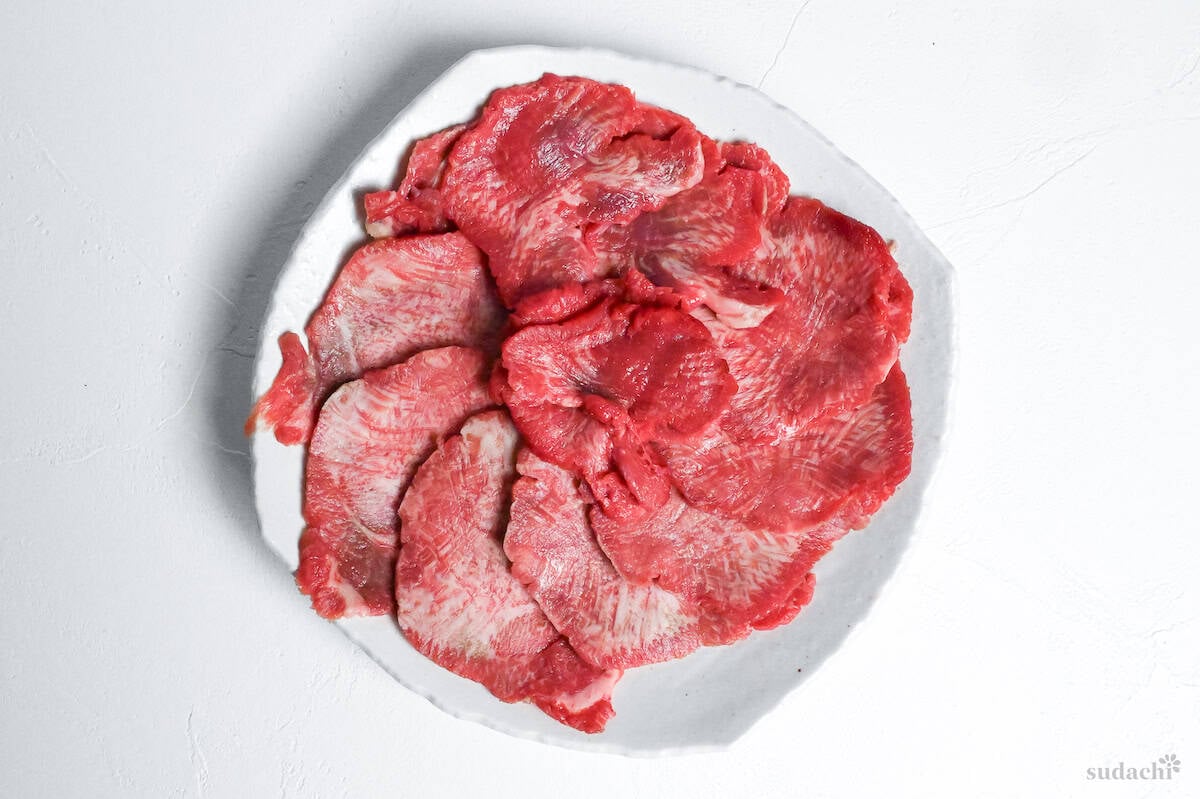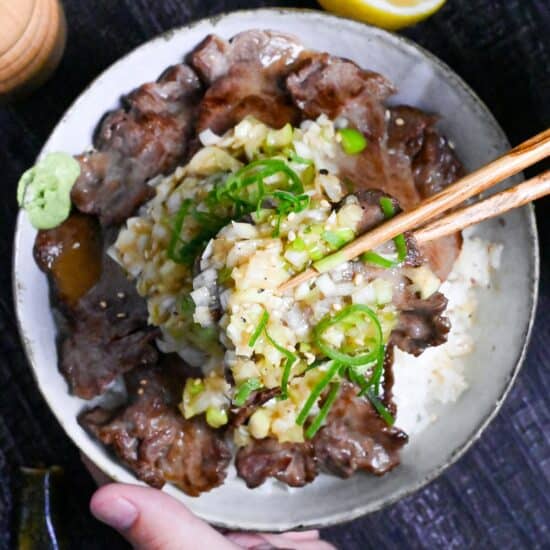Featured Comment:
“This is an absolutely unusual but stunning take on beef tongue, which appears only brined and/ or pre-boiled on classic European menus as far as I know (or sometimes cured as a cold cut). I’m glad I finally figured out how to get it sliced professionally and extra thin. It really took the cake, everyone loved it.”
– Peti
What is Gyutan?
Can a humble frying pan deliver the same mouthwatering gyutan you’ve craved since your last visit to a Japanese yakiniku spot?
Gyutan, which literally means “beef tongue” in Japanese, is seared to perfection, and it transforms into tender, lean ribbons that have a subtle chew that’s both surprising and refreshing.

If you’re nervous about working with beef tongue in your own kitchen, don’t be! This recipe breaks down every step to help you feel more confident in recreating that gyutan from a yakiniku restaurant in Japan.What makes my recipe really special is how flexible it is: it’s got a simple yet flavor-packed sauce that goes really well with all kinds of meat.
Ready to spark conversation at your next dinner with your Japan travel buddies? Move on to the detailed instructions, and let’s reminisce about those magical days together.
Key Ingredients & Beef Tongue Alternatives

- Japanese leek (negi): These mild, sweet onions are a perfect pairing with the tongue. Substitute with the white parts of regular leeks (chopped extra finely) or green onions if negi isn’t available.
- Toasted sesame oil: This aromatic oil is essential for my special sauce. Its nutty, roasted flavor cannot be replicated with regular sesame oil. Look for bottles labeled “toasted” or “roasted” in the Asian foods aisle.
- Soy sauce, Miso, & Chicken bouillon powder: These are essential for adding depth, and if you can, using Japanese ones will help you get the most accurate flavor of my recipe.

For beef tongue, look for pre-sliced tongue at Asian markets to save prep time, or ask your butcher to slice a whole tongue into 5mm pieces perpendicular to the grain. Your local butcher might keep frozen tongue in back storage even if it’s not displayed, so don’t hesitate to ask! You might even be able to pre-order a fresh one with advance notice.
Mexican markets can be another excellent source since beef tongue is consumed in their cuisine.

If working with the whole tongue by yourself, remove the thick outer membrane first and use the middle or base sections, which are most commonly used for yakiniku.
Can’t find beef tongue or still feeling hesitant about trying it? No worries! My special shiodare sauce works beautifully with other meats too! Here’s how different protein candidates compare:
| Protein | Flavor Profile | Best For |
|---|---|---|
| Pork Tongue | Similar richness, slightly milder | Someone who can get pork tongue |
| Beef Steak Cuts | Classic beefy flavor | Traditional yakiniku experience |
| Thick-Cut Pork Belly | Rich, fatty, indulgent | Those who love fatty cuts |
| Chicken Thigh | Mild, juicy | Lighter, family-friendly option |

Pork tongue is your closest substitute! Smaller and leaner than beef tongue, but with similar texture and significantly lower cost. It’s actually getting more and more popular in Japan these days too.
Just keep in mind that the cooking time depends on how thick the protein is and how much fat it has.
Jump to Full Recipe MeasurementsVisual Walkthrough & Tips
Here are my step-by-step instructions for how to make Gyutan Don at home. For ingredient quantities and simplified instructions, scroll down for the Printable Recipe Card below.
If you prefer to watch the process in action, check out my YouTube video of this Gyutan Don recipe for a complete visual walkthrough!
To start, sprinkle a few pinches of salt on beef tongue slices and set them aside.

Then whisk together all the sauce ingredients (Japanese leek, toasted sesame oil, lemon juice, honey, soy sauce, salt, miso, black pepper, grated garlic, and chicken bouillon powder) until they’re well combined.

Let this mixture rest for 10 minutes so the flavors can get to know each other.

This brief wait time is key for getting the flavors just right. The salt pulls moisture from the leek, and the miso and garlic release their aromatics, making a more cohesive and balanced sauce.
Add beef suet (or cooking oil) to your pan and heat over high heat until it’s properly preheated. This high-heat approach is essential for achieving the signature char that makes gyutan so irresistible.

Cast iron or carbon steel pans are perfect for this recipe because they hold heat well. I’ve found that my cast iron pan produces the best results, but you’ve got to properly season and preheat it thoroughly to prevent sticking. If you’re using nonstick, that works perfectly fine too, just make sure it’s rated for high-heat cooking.
Place sliced beef tongue in the hot pan and sear for 1 minute to 1 minute and 30 seconds, depending on thickness. For my 5mm slices, this range was perfect. You’re looking for visible browning and the appearance of meat juices on the surface.

The goal here is achieving proper Maillard reaction, that beautiful browning that creates complex, savory flavors essential to authentic gyutan. You want a high-temperature sear on the outside while keeping the interior from overcooking. As juices appear on the surface, gently blot them with a paper towel (which is very important!).

If your tongue slices are a lot thicker than 5mm, start with medium heat to ensure even cooking throughout, then finish with high heat for the final sear.
Turn the tongue slices and cook for just 30 seconds more. Resist the urge to cook longer! Overcooking will result in a tough, chewy texture that defeats the purpose of this dish.

For those wanting an extra smoky flavor, you can finish with a blowtorch for a few seconds, though this is completely optional and more for dramatic presentation.
Serve rice in individual bowls and add a small amount of sauce directly to the rice, allowing it to soak in slightly. Top with the seared beef tongue, then generously spoon the remaining sauce over everything.

Finish with a small dollop of wasabi and a sprinkle of toasted sesame seeds.
Jump to Full Recipe Measurements
Essential Tips & Tricks
- Let your sauce rest for 10 minutes to allow the flavors to develop.
- Blot surface juices of the beef tongue with paper towels during cooking.
- Keep the second side of the beef tongue cooking time to just 30 seconds.
- Sauce the rice first, then add the meat. This creates layers of flavor throughout the dish.
- Ask your butcher for help. They might keep beef tongue in back storage even if it’s not displayed, so don’t hesitate to ask.
With these simple tips in mind, you’re set for success every time you make Gyutan Don.
Meal Prep & Storage
This gyutan recipe is not ideal for full meal prep since beef tongue becomes tough and loses its tender texture when reheated. However, you can prep components ahead for quicker assembly during the week.
- Sauce Prep Only: Make the sauce up to 1-2 days ahead and refrigerate in an airtight container or bowl. Cook the beef tongue fresh when ready to serve.
- Fresh Tongue Storage: If buying in bulk, portion raw tongue into single-serving sizes, pat completely dry with paper towels, wrap tightly in plastic wrap, put them in a freezer bag, and freeze for up to 1 month. Thaw completely in the refrigerator before cooking.
Serving Suggestions
FAQ
Here are answers to frequently asked questions I have received across all platforms, including here, YouTube, Instagram, and Pinterest. If you have any questions, feel free to send them to me anytime! It will be a big help for everyone in this community!
This usually happens from overcooking or using too high heat for too long. For thick cuts, sear on high heat briefly, then reduce to low heat or turn off and let residual heat finish cooking. For thin slices, stick to high heat but watch the timing carefully.
Never cook frozen beef tongue. It will be raw in the center while overcooked on the outside. Always thaw completely in the refrigerator first.
If you see a white, tough-looking skin on the surface, it needs to be removed or it will cause extreme shrinkage and a rubbery texture. Use a knife tip to catch an edge and peel it away. Pre-sliced tongue from Asian markets usually has this already done.

I hope you enjoy this Gyutan Don recipe! If you try it out, I’d really appreciate it if you could spare a moment to let me know what you thought by giving a review and star rating in the comments below. It’s also helpful to share any adjustments you made to the recipe with our other readers. Thank you!
More Japanese Beef Recipes
Hungry for more? Explore my beef recipe collection to find your next favorite dishes!

Gyutan Donburi (with Negi Shio Sauce)
Ingredients
- 250 g thinly sliced beef tongue room temperature, about 5mm thick, membrane removed
- salt
- 1 tsp beef suet (fat) or neutral cooking oil
- 2 ptn cooked Japanese short-grain rice
Shiodare Sauce
- 100 g Japanese leek (naganegi) finely diced, or regular leek white parts, or green onions
- 2 tbsp toasted sesame oil
- 1 tsp lemon juice
- 1 tsp honey or sugar
- 1 clove grated garlic
- ½ tsp sea salt
- ½ tsp Chinese-style chicken bouillon powder or dashi granules
- ½ tsp yellow miso paste (awase)
- ¼ tsp Japanese soy sauce (koikuchi shoyu)
- ⅛ tsp ground black pepper
Toppings
- toasted white sesame seeds
- chopped green onions
- wasabi paste
My recommended brands of ingredients and seasonings can be found in my Japanese pantry guide.
Can’t find certain Japanese ingredients? See my substitution guide here.
Instructions
- Sprinkle 250 g thinly sliced beef tongue with a few pinches of salt and set by the stove.

- Finely dice the white part of 100 g Japanese leek (naganegi). In a separate bowl, combine 2 tbsp toasted sesame oil, 1 tsp lemon juice, 1 tsp honey, 1 clove grated garlic, ½ tsp sea salt, ½ tsp Chinese-style chicken bouillon powder, ½ tsp yellow miso paste (awase), ¼ tsp Japanese soy sauce (koikuchi shoyu), and ⅛ tsp ground black pepper. Once smooth, pour it over the leek, mix and set aside for 10 minutes.

- Heat a cast iron pan on high and add 1 tsp beef suet (fat) or a drizzle of cooking oil.

- Once smoking hot, add the beef tongue slices in a single layer and sear for 1 – 1 min 30 seconds (depending on thickness) while dabbing the tops with kitchen paper to remove excess juices.

- Flip and sear the other side for 30 seconds.

- Prepare 2 ptn cooked Japanese short-grain rice and add a small amount of negi shio sauce directly on the rice before arranging the beef tongue slices on top. Divide the rest of the sauce between each serving and sprinkle with toasted white sesame seeds, chopped green onions and a blob of wasabi paste. Enjoy!

Video
Notes
- If you can’t get Japanese leek, use regular leek or green onions.
- For tips on how to cut Japanese leek, check out the how to cut negi (mijin-giri) section of my What is Negi? article.
- This dish also works well with beef steak, pork belly slices and even chicken thigh. When using substitutions, adjust the cooking time as necessary.
- If you can’t fit the beef tongue in a single layer in your pan, cook in batches to avoid over-crowding.
- This recipe is based on using beef tongue cut 5mm or thinner. If using thicker cuts, use a medium heat to ensure it cooks all the way through, then increase the heat at the end for a final sear.






This is an absolutely unusual but stunning take on beef tongue, which appears only brined and/ or pre-boiled on classic European menus as far as I know (or sometimes cured as a cold cut). I’m glad I finally figured out how to get it sliced professionally and extra thin. It really took the cake, everyone loved it.
Hi Peti,
Thank you for trying this recipe! So glad everyone enjoyed it! I actually haven’t tried the European style yet, but now you’ve got me curious to try them! 🙂
Yuto
Do you cook and peel the tongue first? Or do you just slice the top skin off and cook the raw meat!!!???
Hi Joe,
Thank you for your question! In Japan, most beef tongue is sold with the outer membrane already removed by the butcher. For that reason, I haven’t personally had to peel it myself. But generally speaking, the Japanese method here is to remove the membrane from the raw tongue first, then slice it before cooking.
I hope this helps clarify!
Yuto